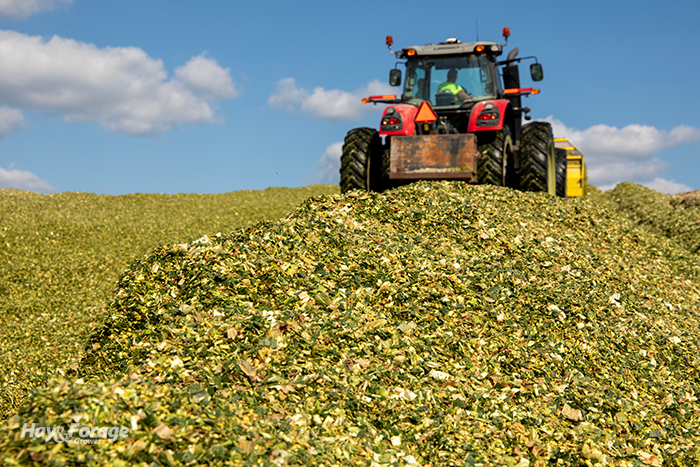
Cereal grain and alfalfa harvests are afoot on many Midwestern farms, and with planting underway, corn will have its harvesting heyday in the second half of the growing season, too. Just because these crops can all be cut for haylage or silage, though, doesn’t mean they are created equal when it comes to fermentation and ensiling.
Factors like moisture content and packing density must be in check to create a high-quality silage product, but two forage characteristics in particular that affect ensiling are water-soluble carbohydrates (WSC) and buffering capacity (BC).
Individual forage species have average ranges for WSC and BC, just like individual players of a starting line-up have different shooting percentages and batting averages. With that said, harvest management and external influences can affect how well these silage crops perform. The relationship between WSC and BC can impact the fermentation process of forage and its feedout stability as well.
In an article from the Midwest Forage Association’s Forage Focus newsletter, Wayne Coblentz explains that WSC is essentially plant sugar content. The retired scientist with the U.S. Dairy Forage Research Center in Madison, Wis., adds that BC is a forage’s inherent resistance to pH change, measured as the milliequivalents of acid required to reduce forage pH from 6 to 4.
Sugars are substrates
Water-soluble carbohydrates are critical to silage production because they serve as substrates for fermentation acids. The two primary fermentation acids are acetic acid and lactic acid, with the latter being the strongest and most desirable acid because of its ability to quickly lower forage pH.
Water-soluble carbohydrate concentration is largely dependent on forage species. Coblentz says forage crops that are common to the north central United States range from 5% to 20% WSC, with corn ranking highest, followed by forage sorghum, and then cool-season grasses. Alfalfa and other legumes rank the lowest. He adds that native-warm season grasses also have notoriously low WSC concentrations, making them especially difficult to ensile.
Other factors that can impact WSC concentrations include plant maturity, growing environment, frost damage, nitrogen fertilization, and even the time of day during harvest. Perhaps the most problematic is rain damage after cutting that impedes forage dry down and exacerbates nutrient loss.
“When this occurs, WSC are lost through direct leaching of sugars and by prolonged or extended respiration before these damaged forages can be wilted suitably for harvest,” Coblentz explains. “Rain damage is typically more severe as forages become drier and lose their cell functions.”
To illustrate this, he refers to a study conducted at the University of Wisconsin Marshfield Agricultural Research Station where 1.1 inches of rain fell on alfalfa wilting in a windrow and caused WSC concentrations to slide from 6.4% to 4.9% on a dry matter basis. A more drastic decline was seen in a second trial where 1.9 inches of rainfall occurred over a prolonged eight-day period, reducing alfalfa WSC concentrations from 6.1% to 2.9%.
“It is important to emphasize initial concentrations of WSC in alfalfa are marginal at best for supporting silage fermentation, and these rain-damaged forages were severely compromised by the noted losses,” Coblentz states.
Consider buffering capacity
With that said, WSC and BC display somewhat of a love-hate relationship with one another. Higher WSC concentrations are required for more lactic acid — and thus a quicker decline in pH — but crops with high BC have a greater resistance to this process.
“To some extent, these two forage characteristics work against each other with respect to a desirable fermentation that includes strong acidification of the silage,” Coblentz asserts. “Adequate WSC are required for production of fermentation acids, but highly buffered crops are more resistant to the desired pH change.”
Coblentz ranks alfalfa and other legumes highest on the BC scale, followed by cool-season grasses, and then corn. With a low BC and high WSC concentrations, he suggests corn is the easiest crop to ensile and properly ferment. Conversely, alfalfa has a high BC and low WSC, so haylage fermentation can be more of a challenge.
“Much of the difference in BC between forages is related to naturally occurring organic acids, their salts, and to a lesser degree, plant proteins,” Coblentz writes. The higher the protein content, the more ammonia forage will produce, and this compound buffers fermentation.
He adds that BC can weaken as both grasses and legumes mature. Furthermore, alfalfa leaves tend to have a greater BC than alfalfa stems, which is noticeable when stands are harvested at earlier stages of maturity.
No matter the inherent WSC or BC of a forage species, harvesting crops at an appropriate moisture content is key to silage management. Coblentz notes this will inhibit the proliferation of clostridia bacteria that can generate end products like butyric acid, ammonia, and amines. Also, applying a homofermentative inoculant that contains lactic acid-producing bacteria will help expedite a drop in pH, which also keeps clostridial activity at bay.
Forage that is too dry, on the other hand, does not provide a welcoming environment for clostridia. However, it can be more difficult to effectively exclude oxygen when dry forage is packed in silage bunkers, bags, or wrapped as baleage.

